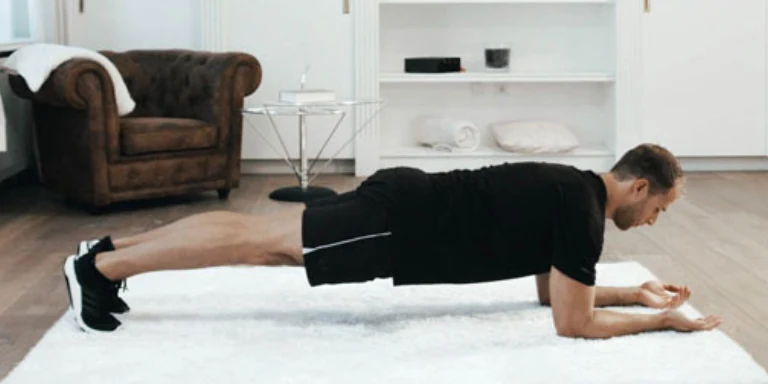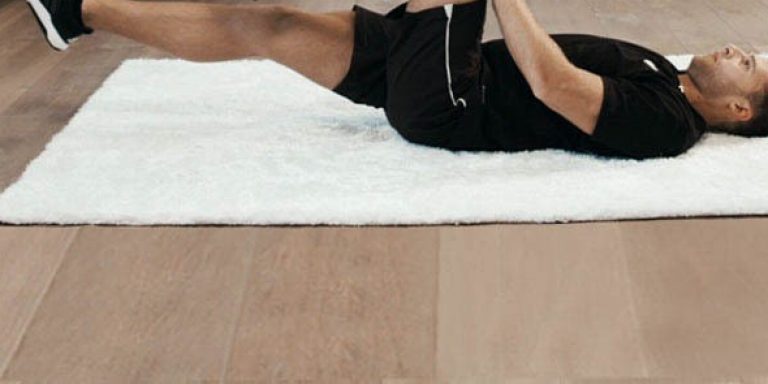
Back exercises and tips for a healthy back
What makes our back strong? These three simple exercises and training tips help combat tension and back pain.
Pain in your lower back, neck and in between your shoulder blades: back pain is one of the most common physical complaints. Every second person suffers regularly from it, as shown in the 2020 Back Report by Rheumaliga Schweiz. What can you do about it?
These three activities can help a lot: exercising, strengthening and relaxing.
Exercising regularly, in a variety of ways
Your back loves movement – preferably different types. Sitting down for too long, weak muscles and strain can lead to tension and back problems.
Depending on your job or specific task, your body experiences one-sided strain. This is why it’s important to do lots of different exercises to reduce pressure on your spine: through stretches, endurance sports and strength training.
Yoga and Pilates are a good addition to classic back exercises. They strengthen the abdominal and core muscles and stretch the muscles of our entire musculoskeletal system.
Back training – strengthen your entire core
A strong back protects you from tension, pain, and from wear and tear of the joints and bones. It also reduces the risk of injuries. A strong core means we are more flexible, our movements are more dynamic and we have a healthy posture. The spine and organs are better protected. Tendons, ligaments, cartilage and even connective tissue benefit from back exercises. And last but not least, muscle training has a pure anti-ageing effect, as it stops age-related muscle degeneration,which is why strength training is always worth it. Plus, it is never too late to start!
Efficient back exercises to do at home
You don’t need complicated equipment or a gym: a mat is enough to keep your back flexible and as free from pain as possible.
Tip: warm up your muscles before strength training: do star jumps, skip or jog on the spot for one minute. Stretching also prepares the muscles. Do the abdominal and back exercises slowly, and avoid any sudden movements.
Low plank

This strengthens your entire core:
Support yourself on your forearms and toes and make a straight line from your head to your toes, looking down at the floor. Create tension: tense your buttocks, draw your navel in.
Hold this position, without letting your hips sag, for around 30 to 60 seconds.
Cobra lat pulldown

Strong spinal erectors ensure more stability and flexibility:
Lying on your stomach, lift up your head and extended arms, and look down at the floor. Now draw your elbows backwards until your hands are at the same level as your chest, and repeat 10 times.
Dead bug

For your rectus abdominis and oblique muscles:
Bend one knee, and press your arm lightly against it. Extend the other leg and the other arm out, without touching the floor. Keep your abdominal muscles tensed. Change side, repeat 10 times. The lower back always should always be touching the floor.
Back exercises with Helsana Coach
The Helsana Coach app helps you to achieve your health goals. In the free app, you can find numerous back exercises with video instructions, as well as stretching exercises and yoga specifically for the back. Download now!
Switch off and relax
Permanent tension is not good for your back. Constant stress causes us to tense our entire body, which is why it’s important to make sure you take regular breaks in day-to-day work and allow yourself time to do your favourite activities.
How often and how hard should you train?
Doing at least two sessions of muscle-strengthening activities a week is recommended. It’s best to incorporate back exercises into your training programme. Ideally, it would contain the following sessions:
- Two full-body strength training sessions for around 30 minutes,
- 10 to 20 minutes of which should be abdominal and back exercises.
- For effective strength training, the muscles should be as exhausted as possible afterwards. In the training session, your muscles should be targeted for 60 to 120 seconds – it doesn’t matter if you do it in one go or broken up into sets.
- You should also do 2.5 hours of moderate-intensity exercise, or 1.25 hours of high-intensity exercise.
- Do as much exercise as possible in your daily life: 10,000 steps a day is ideal.
Watch out for these mistakes
- Cold muscles: only warm muscles can achieve the best performance. Warm them up and start slowly.
- Too little regeneration: muscles grow during the recovery phases. You need to take a break for 24 to 48 hours, depending on the training.
- Wrong breathing: never hold your breath, but breath rhythmically: breath in when the muscles are tensed, breath out when you release them.
- One-sided muscle training: regularly change the type of exercises and strengthen your entire body to avoid any imbalances.
- Strain: adjust the difficulty to your own strength so you can carry out the exercise with correct form (check using a mirror). For safety, watch the videos in the Helsana Coach app for each exercise, or take part in a fitness course.
Back training – what Helsana will pay
COMPLETA supplementary insurance covers 75% of the costs of health promotion courses such as strength training, yoga or back exercises, up to a maximum of CHF 200 per year.
What should you do if you have back pain?
Even in the case of acute back pain, exercise is generally better than doing nothing. Bed rest can make the pain worse.
How to stay active
- Walking, Nordic walking, front crawl and backstroke can help your back.
- Do back exercises for stretching and mobilisation e.g. shoulder stretches, cat-cow, child’s pose, or other gentle yoga exercises.
- Gentle strength exercises – know and respect your pain threshold.
- Fascia rolling releases the connective tissue, but be careful if you have a herniated disc or osteoporosis.
- Avoid sitting down for a long time, and loosen your muscles and stretch several times a day.
- Incorporate relaxation breaks into your daily life.
Our health consultation advisors will show you how to relieve back pain. Together, they’ll help you find out what the cause of your pain is.
Get advice on back pain after a month
Give your back time. However, if your back pain lasts longer than four weeks or if you have any other symptoms, you should consult a medical professional to get to the bottom if it, as back pain can have a wide variety of causes.
For patients
Are you already getting treatment for back pain? Then please talk to your doctor or therapist. A therapy tailored to you and an individual training plan are important.

The specialist provided the editorial team with advice and input for this article. Evelyne Dürr (Msc in Human Movement Sciences, ETH; CAS workplace health promotion) was working for Helsana’s health consultation service at the time the article was written.



Newsletter
Find out more about current health issues every month and get all the information you need about our attractive offers from all Helsana Group companies * delivered by e-mail to read whenever it suits you. Our newsletter is free of charge and you can sign up here:
We did not receive your information. Please try again later.
* The Helsana Group comprises Helsana Insurance Company Ltd, Helsana Supplementary Insurances Ltd and Helsana Accidents Ltd.
